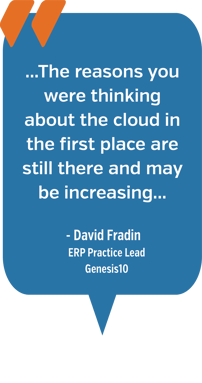We recently asked Alan Manuel, Chief Product Officer at Protera Technologies, and David Fradin, ERP Practice Lead at Genesis10, to articulate compelling reasons for organizations to move aging on-premises SAP platforms to the cloud. Protera and Genesis10 are in a strategic relationship to help their respective clients with moving their ERP systems to the cloud.

In part one of this blog series, we looked at reasons for moving to the cloud, timing a move and the triggers that can propel organizations to act now. Now, we dig into the benefits, respond to security concerns, share strategies for staff augmentation and provide next steps for moving forward.
What benefits does the cloud offer organizations running SAP?

In addition to the cost, quality and analytics benefits which we covered in part one of this blog, moving SAP to the cloud provides such benefits as increased agility, flexibility and the promise of digital transformation as well as a smaller footprint in the operation, says Manuel. “That’s very attractive to people who run the company.”
He recalls a CEO saying recently that the cloud can help an organization running SAP become more agile, which means they can experiment or try things such as a new product or technology or way of marketing much more quickly. SAP architected its HANA platform to improve business agility. “Before, if you wanted to make changes to your business you had to make changes to your SAP platform and that was very difficult,” Manuel says. “A key benefit to organizations running on the cloud is that they can be more experimental and more innovative—and they can react more quickly when the experiments fail or succeed. series, moving SAP to the cloud provides such benefits as increased agility, flexibility and the promise of digital transformation as well as a smaller footprint in the operation. That’s very attractive to people who run the company.”
“For example, a client on an older version of SAP (BW on premises) considering a move to the cloud thought they had to spend hundreds of thousands of dollars on hardware and software licenses and that it would take several months to get up and running before they could even begin the project. But, with partners like Protera Technologies and Genesis10, they could get that provisioned immediately in less and quickly get started on their project.”
To add to that, the cloud gets organizations out of the business of running large IT shops with specialized skills. With the cloud, IT operations just got a whole lot simpler. For one, a special room with servers that are costly to operate and manage are no longer needed. These costs are figured into the monthly fee paid to the cloud provider.
How should organizations react to SAP extending support to 2027?
Fradin’s advice is to not get overwhelmed, but rather develop a plan. “The time to start a move to the cloud is now. There is time but we also know all too well how priorities shift.,” he says.

Manuel suggests looking at what has changed and has not changed with the news. “An organization’s business hasn’t changed. The constant need to serve its customers hasn’t changed. They haven’t stopped wanting more. The boss hasn’t stopped wanting it done for less. All the pressures to evolve, innovate and roll things out more quickly are still there. The only thing that really changed is that your software vendor has made a change to its policy.
“To Dave’s point, we have to keep going. The reasons you were thinking about the cloud in the first place are still there and may be increasing. You do not know what SAP is going to do on the application level so you need to put yourself in the best position to make the choice on your terms, with your timing. With that in mind, it’s now more important than ever to get your application up to the cloud. From there, you can decide on the next step.”
How should organizations proceed?
“If you are uncertain about moving to the cloud, gather your information and do an assessment with a tool like Protera FlexBridge,” Manuel says. “It’s not like the old days, when you first implemented SAP and had to do a big-bang project. You can do things in a more agile fashion. Get a pilot, or proof of concept, going, get that first instance going in the cloud with your own data. From there, you can see whether the journey will be easy or complex and what the benefits could be. Once you’re using an application on the cloud, you can plan the next steps of your transformation.”
What strategies are organizations using to augment already strained IT staff?
Genesis10 can help bridge any gap in an IT workforce by providing the expertise on new products like HANA S4 that organizations may not have in house, says Fradin. “We will hit the ground running, from leadership to development. At the same time, most companies will reward their better employees by letting them work on new projects, often creating a gap in the old system. Genesis10 can provide support for the legacy system during the transition period with additional manpower.”
Protera can help by providing technical services efficiently and at scale that allow an organization’s key staff to spend more time on high value projects such as developing a new application for a customer and less time on such tasks as backing up a database, says Manuel. “It’s a classic message, but now more than ever, it’s true.”
What strategies do you suggest businesses use to mitigate perceived risks of running SAP on the cloud?
Going back two or three years, there was a fair amount of resistance to going to the cloud. “Clients and prospects were telling us that they didn’t want to put their financial data in a public database where anyone could see it,” Fradin says. “They didn’t go to the cloud for that reason. Over the past several years, hyper scalers such as Amazon, Microsoft, and Google all invested in securing the public cloud, with objections just about evaporating. There is more trust now in the hyper scalers because of their investments in security. In addition, there are monitoring tools and governance, risk and compliance packages (GRC) that can be added to allow the enforcement of segregation of duties.”
Adding to that, to mitigate perceived risks of running SAP in the cloud, Manuel suggests organizations:
- Consider using services or providers that are SAP certified.
- Look for providers with experience. Experienced providers can keep pace with the continual flow of new opportunities as well as the risks and challenges associated with security.
- Seek transparency: Organizations need insight into how their application is being run at the infrastructure or application level using such key metrics as security, capacity, performance and availability.
Why Cloud? Why Now? Fradin reminds organizations that on-premises platforms are aging. “The cloud offers tremendous opportunity for digital transformation as well as business transformation,” he says. Protera and Genesis10 have partnered to support you. The time is now.”
If you would like to schedule a video conference call with Genesis10's David Fradin and Protera's Alan Manuel to answer any questions that you might have about moving SAP to the cloud, please contact me and I will facilitate scheduling.
In part one of this series, we look at reasons for moving to the cloud, timing a move and the triggers that can propel organizations to act now.



